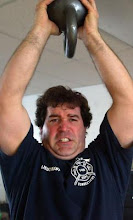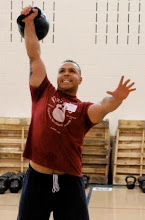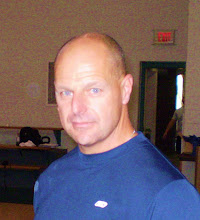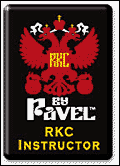
Atlantic City ,New Jersey firefighter John Slattery RKC leads local firefighters in kettlebell training excercises during seminar in Bridgeport CT. (Phil Noel/Staff photographer)
CT Post Article, Saturday February 21, 2009 By Genevieve Reilly, staff writer
A hissing sound was coming from the second floor at Connecticut Tank Removal in Bridgeport. After a sustained period of hissing, there was a series of sharp thuds.
"Okay, now we're going to do hot potato," said Zar Horton, as he lifted the metal ball, called a kettlebell, over his head. "Grab the ground with your toes and we're going to do 20 touches."
Horton shifted the kettlebell -- resembling a cannonball with handles -- from one hand to another as he counted to 20, then had the group begin again, this time repeating the exercise 18 times. It was the second day of a two-day seminar where the group of about 40 people, mostly area firefighters, had been learning how to use the kettlebells for strength and fitness training.
The good-natured groans from the trainees got worse when Charles Bustos took over.
While Horton had introduced the participants to the finer points of kettlebells, Bustos was going to take them through the paces of body tensioning. The participants, like Fairfield Firefighter Wayne Parks, went into a crouch position, arms flexed out in front of them, knees together.
"Squeeze in, not just down," Bustos said. "Drive your feet into the ground."
Faces turned red, sweat popped on brows, and the hissing -- the sound of the exercisers breathing -- became louder. The thuds, of course, were produced as the exhausted exercisers dropped their burden.
"You're making your body work more efficiently," he said.
"We're fixing the weak link."
Each position looked, and sounded, like a mild form of torture to the unitiated, and the firefighters weren't afraid to let Bustos know it.
"I hate you, Charles," said one. "What did your parents do to you when you were little?" asked another.
But despite the barbs, the firefighters were enthusiastic about the class. "I recently started re-focusing on strength training," Parks said, who heard about kettlebell training through his fellow firefighter, Assistant Chief George Gomola. "I didn't klnow what it would be like. I thought they'd take it easy on us, since its just two days."
Kettlebells vary in weight, depending on the user's own weight and state of physical fitness. The average man starts with a 35-pound kettlebell, but they range in weight from 10 pounds to more than 100 pounds. They have been used in training by the Russian military for special forces personnel and, more recently, for the U.S. government's training of elite military units. Gradually, the kettlebell training is filtering down to a wider, non-military audience.
Gomola, who is a certified kettlebell instructor, is eager to talk about the training method, which he feels can be invaluable to fellow firefighters by helping them do their jobs and live longer.
Firefighters, he said, are asked to perform short spurts of intense physical activity after periods of inactivity when they're called to a fire or car accident, and kettlebell training helps train the body for that.
"These principles can be applied to any physical activity from sitting down in a chair to walking up stairs to pulling somebody out of a fire," said Gomola, who is also the strength and conditioning coach for the Sacred Heart University men's soccer program.
Horton, a New Mexico firefighter, recounts case histories of a friend who had shoulder and knee problems and a female firefighter who lacked upper body strength. Both benefited tremendously from physical training with kettlebells, he said.
"Kettlebell training forces you to get in touch with your body and how it works," Gomola said. "It's more like a gateway than an exercise program. Once you get in touch with your body, you truly are on a path to fitness. You'll never get that experience lifting weights in a gym."
About 40 people turned out for the recent seminar, although not all were firefighters or even adults.
Fifteen-year-old Shannon Curry's father, Steve, is an assistant fire chief in Fairfield. A three-sport athlete at Fairfield Warde High School, Shannon said she participated in Gomola's "program one summer with kettlebells and I really liked it.
"I think it's an effective workout."
She said she used to train with weight machines, but has founds that kettlebells meet so many more needs than those did.
After Horton and Bustos took workshop participants through their paces with the kettlebells and muscle tensioning, it was time for some gentle stretching and breathing, as they slowly unwound from the day's workout.
Stamford Fire Capt. Pat Tripodi learned about the program from a flier for the course at his firehouse. "Our union is very big on physical fitness," Tripodi said, especially with the high rate of heart and hypertension problems among those on the job.
"One thing we talked about for a couple of years was kettlebells," Tripodi said, and he and a few of his men signed up. When Tripodi returned to work after the Saturday session, "a lot of guys had questions and wanted to know about it."
Using the kettlebells, he said, also appears to be a quick and cost-effective way of maintaining firefighters' fitness.
"This is ideal for the kind of work we do," Tripodi said. "You can get the benefits in a 20- or 25-minute workout." And with the cost of a kettlebell at approximately $75 each, it would cost his department less than $1,000 to provide enough kettlebells for an eight-person shift at a firehouse.


























No comments:
Post a Comment